Why choose open source over proprietary software for enterprise projects
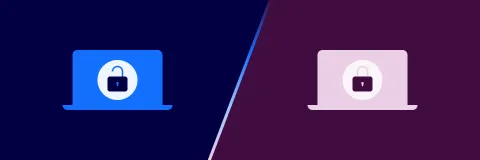
We often get asked what open source software is and why companies prefer it over proprietary software. The short answer is: it is cheaper in both the short and the long run because it has no license costs. It also reduces risk because there is no lock-in with the vendor of the software. And it is usually safer and better because the source code is open and can be improved by anyone.
This can also be confirmed by comparing the latest global study on open source adoption conducted by the company OpenLogic and the non-profit organization Open Source Initiative.
They´ve highlighted the following top reasons for organizations to use open-source software:
- Access to innovations and latest technologies
- No license cost, overall cost reduction
- Modernize technology stack
- Constant releases and patches
- Less vendor lock-in
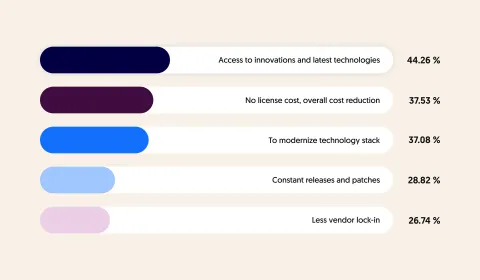
Source: 2022 State of Open Source Report by OpenLogic and Open Source Initiative
If you are a decision maker in your company or you advise companies to make the right decisions when choosing the best software solutions, then this article is for you.
The four essential freedoms of open source software
You probably already know what open source is, but here is a brief summary useful for the arguments made in this text.
Open source software is also referred to as free software and it is distributed with a usage license that grants you four essential rights:
- You can use the software for anything, as much as you want and without any restrictions such as license expiry or geographic limitations.
- You can study and analyze the source code in detail without non‐disclosure agreements or similar restrictions.
- You can copy the software and share it with anyone at virtually no cost.
- You can improve or modify the software to better meet your requirements and you can share these improvements publicly.
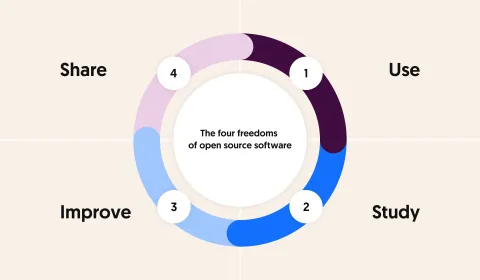
More details about the four freedoms of free software can be found on the website of the Free Software Foundation. There, you can also find detailed information about standard open source software license types.
Even though these four essential rights are simple, the implications have a significant business impact. This is particularly true if you select software for large enterprise-grade projects.
Why open source software is the right choice for your enterprise
To help you make an informed decision, let’s break down what the main strengths of free software against proprietary software are.
The strengths of the open-source software are organized as follows:
Open source software has no license cost
Open source software has lower maintenance costs
Open source software is safer and more innovative
Open source software is more flexible
After the breakdown, we provide you with some real examples of open source projects and how they work:
What are some prominent examples of open source software?
How do providers of open source software earn money?
Lastly, we summarize our findings and work out the advantages of choosing open source software over proprietary software.
What is the benefit of using open source software?
To follow the arguments in this text let’s assume you have two similar software options available to you. One is open source software and the other is proprietary software.
Open source software has no license cost
As for most business decisions, cost is one of the most crucial factors when deciding.
Regardless of whether you choose open source or proprietary software, your vendor has to be able to deliver the project with a profit.
In the case of proprietary software, your cost would usually include the cost of the license and the cost of the service. For open source software, it would typically only contain the service cost.
If the vendor of the proprietary software is also the manufacturer of the software, you can directly compare the cost between the two vendors, because it does not matter to the vendor whether the work is invoiced as a service or as a license cost.
However, if the vendor is a reseller of the proprietary software or a delivery partner of the software provider, then the vendor has to pay parts of the license fee to the owner of the software. All else equal, the vendor of the proprietary software would have to charge you more than the vendor of the open source software to achieve the same profit.
This does not apply to vendors of free software. Because the vendor of the open source software does not have to pay any fees, the cost will be lower compared to the proprietary software.
Open source software has lower maintenance costs
Let’s not forget that all software needs to be maintained. Especially in the enterprise field where high security standards are required, updating software is essential.
Too often, buyers do not pay enough attention to the total cost of ownership when selecting a software solution. Therefore, you should pay attention to the cost of maintaining and adding new features to your software.
If the cost of maintaining your software is too high, the problem is usually your vendor. Either the vendor has difficulties maintaining your software efficiently, the vendor has to pay license fees to the software manufacturer, or the vendor is simply overcharging you.
With free software there are no restrictions on who can maintain your software. Any company specializing in your software can take over the maintenance. You can even choose to in-source the maintenance to your internal IT department. With proprietary software this can be prohibited and sometimes only limited partners for maintenance are available. This is called the vendor lock-in effect.
You can better optimize the relationship with your vendor when using free software. As a result, you usually have lower maintenance costs.
Open source software is safer and more innovative
If you have selected open source software, you are free to study, analyze and modify the software in any way you want. As a result, you might discover security vulnerabilities and fix them, or you could write extensions and contribute them back to the open source project.
If the software you use is widely adopted, the above happens all the time and the users of the software all collaborate. As a result, security flaws are usually fixed more quickly compared with proprietary software.
Furthermore, new features are developed in collaboration and follow the needs of the market, because anyone can extend the software. As a result, open source software is usually more innovative compared to similar proprietary alternatives. The innovation potential of open-source software came out as the top driver for adoption according to the latest global study on open source adoption by the company OpenLogic and the non-profit organization Open Source Initiative.
This is different for proprietary software: since only authorized partners or the manufacturer can make changes, it can happen that important features are not implemented or are very costly. There can be many reasons for this. Maybe other features are more important to the manufacturer, because they yield higher margins, or the manufacturer simply decides to develop the software in a direction that does not fit your use case.
In this scenario, there is usually nothing you can do. You are using proprietary software, you must comply with its license, and you are locked in with the vendor.
Open source software is more flexible
As described above, you can use open source software for anything you want, as much as you want, and without any restrictions such as license expiry or geographic limitations.
This means you can install the software you have used in one project in unlimited other projects. Furthermore, you can modify it to fit it to the specific needs of your organization. Often this is prohibited with proprietary software because the economic goal is to maximize license fees.
With free software you avoid the so-called vendor lock-in. Proprietary software is often tied to specific vendors, which can limit your organization's ability to switch to different solutions if needed. By definition open source software is not tied to any specific vendor and gives you the freedom to choose who develops and maintains your software including yourself. This is why it is considered to be more flexible.
What are some prominent examples of open source software?
You often hear that open source software or free software is used everywhere and that you use it every day.
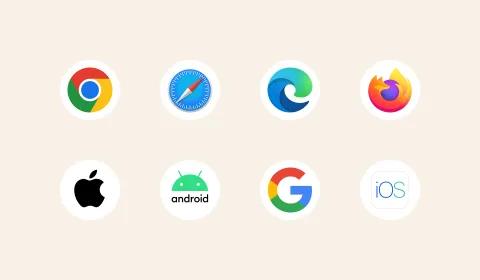
Let’s look at some examples.
If you are reading this article on a mobile device, the chances are high that you are using an Android or Apple (iOS) device. The former is fully open source and the latter is largely based on open source components. You are probably using one of the browsers Chrome, Safari, Edge, or Firefox. All are open source.
When you are browsing the web like right now, the content you are seeing is very likely being served through a Linux operating system, via an Apache or Nginx web server using a MySQL or MariaDB database and is delivered using a reverse proxy that is potentially built using Varnish. The software generating the websites or apps that you are seeing is most likely implemented in PHP or Java or Javascript or one of the frameworks built on top of these.
This list could be endless, especially if you go deeper into the different technology areas. On purpose we have selected examples of prominent software that are used by all people on a daily basis.
How do providers of open source software earn money?
Maybe you have asked yourself this question: if my software vendor uses open source software that is not their own, how does the manufacturer of that software actually earn money?
This is a good question, and there are many answers and solutions.
Some manufacturers of open source software vendors provide dedicated hosting solutions that are optimized for the software and can be delivered at scale.
Others provide proprietary extensions to the software or create profitable market place solutions for extending the software.
If you want to learn more about open source business models there is a lot of information available if you research on the internet.
At 1xINTERNET we build web software using the open source enterprise framework Drupal, and we actively contribute to the development of the software. For Drupal, we can provide first-hand information on how the participants in the ecosystem earn money.
The most well-known organization is the Drupal Association, which provides the main website Drupal.org and hosts the source code of Drupal. The Drupal Association is funded by organizing paid events for its users, by collecting membership fees, and by providing paid marketing opportunities for its partners.
Many companies, such as ourselves, earn money by selling development services for implementing software solutions based on Drupal. Other companies sell hosting services or focus on maintenance and optimization of the software.
Drupal is more than 20 years old, it is a well established web software, and has a very lively ecosystem of organizations and individuals collaborating to develop and maintain the software. Every year more than 1.000 companies and more than 5.000 developers contribute to the project.
The bottom line is that open source is a strong business model with a lot of growth potential for organizations.
This is also reflected in the market, and the global market size of open source software was estimated to be around 23 billion USD in 2022 and grow to 61 billion USD by 2028 according to the latest market growth report published in 2023.
Forecast growth of the global open source software market from 2022 to 2028

Source: Market Growth Reports 2023
A successful open source software will always have a lot of vendors because there will be many opportunities to make good business. If you choose open source software, you benefit from the strength of this business model.
What is the benefit of using open source software?
At 1xINTERNET we build enterprise-grade web software such as CMS solutions, multisite solutions, e-commerce solutions, social intranet solutions, digital asset management systems, search solutions and native apps. We exclusively use open source software. The ownership of all software we deliver is completely transferred to our clients. The source code is completely available and we attach no strings to using any software we provide.
We often take over software solutions previously built with proprietary software solutions or we compete in pitch situations against proprietary software.
In our experience, the cost saving from using open source software compared to proprietary software is at least 30% on the first project alone.
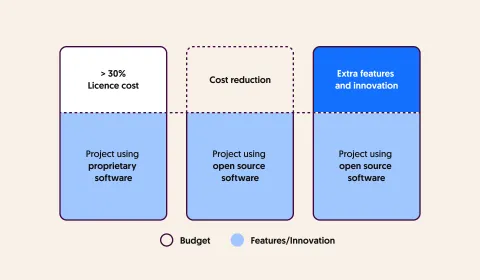
Of course, this is only true if the software is comparable. For our main technology Drupal this is easy, because Drupal is one of the most established software frameworks in the market. In our experience, when comparing cost with similar proprietary software frameworks these cost savings hold.
For you as a buyer this means that you can either save more than 30% of the cost or you have more than 30% additional budget for extra features and innovation.
Over time, this effect will increase, because modern software projects always need constant development. Read more about how to budget successful software projects over time.
By choosing open source software, you will be more successful in implementing new software in your company, both in the short and in the long term.
Other highlights
Using a MVP approach for web projects
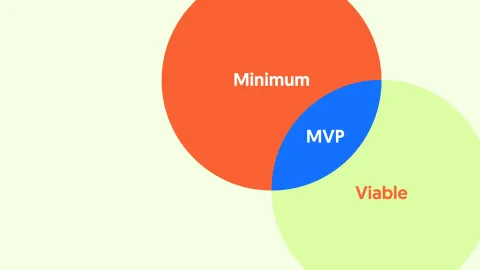
At 1xINTERNET we use a MVP (Minimum Viable Product) approach for delivering successful web projects...
Why and how we use Tailwind CSS

In this article we are going to give an overview of Tailwind CSS, highlight the most important...